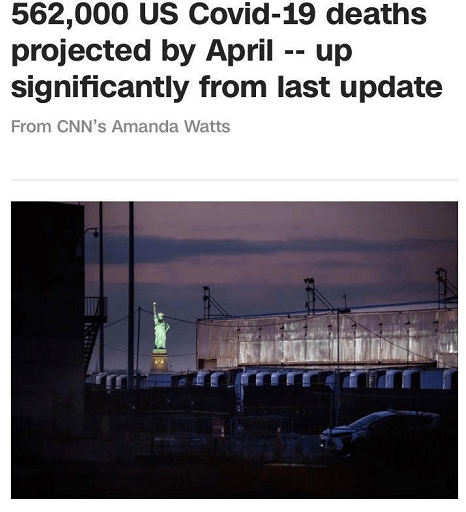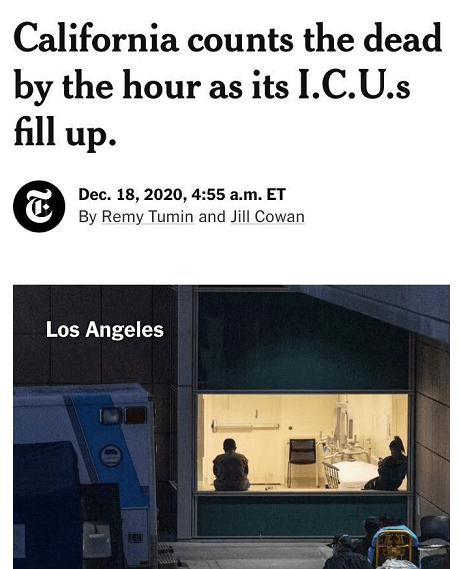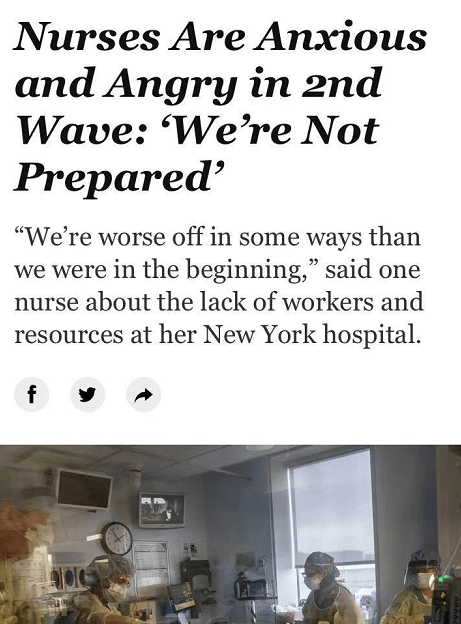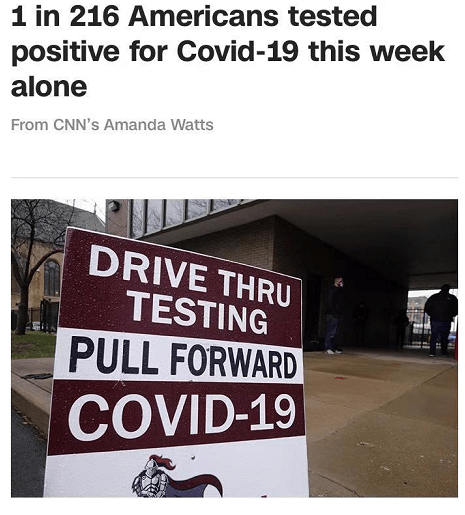December 18th, local time, CNN reported that by April 1, 2021, a total of 562,000 people may die of COVID-19 in the United States, which will also put extreme pressure on hospitals across the United States.
The media pointed out that the continuous high-load operation of American hospitals has overwhelmed medical personnel, and some front-line workers said bluntly that the United States is still not prepared for another peak of the epidemic.

△CNN reports that by April 1, 2021, a total of 562,000 people may die of COVID-19 in the United States.
May die 560,000 people in April next year, and the peak of deaths next month
The forecast model cited by CNN report comes from the Institute of Health Metrology and Evaluation of the University of Washington, which currently has the most influential model of all projections.
The report pointed out that the Institute has significantly adjusted its forecast in the last week, and raised the death forecast until April 1, 2021 from the original 502,000 to 562,000.
The Institute notes that the forecast model was updated because it saw a surge in confirmed cases and deaths since December.
The institute also pointed out that the hospital system will also be under great pressure as a result: “From December to April next year, the capacity of intensive care units in 49 states will be under great or extreme pressure. Overall, we expect that the daily death toll will continue to increase nationwide, reaching a peak of more than 3,750 deaths per day by mid-January.”

△ The New York Times reports that on average, two people die of COVID-19 every hour in Los Angeles County, California, and one in 80 people are infected.
California counts deaths by the hour, and there is a shortage of beds in the living areas of 30% of the population in the United States.
The model also pointed out that the sharp increase in death data in California in recent days is of concern. According to the New York Times, Los Angeles County currently has an average of two deaths per hour from COVID-19, and one in 80 people is infected.
“Our hospital is under siege, and predictive models show no end,” said Christine Galli, director of health services for Los Angeles County on Dec. 17.
Gary warned that California’s statewide ICU is currently only 3%, and it is likely that not only all 2,500 ICU beds will be exhausted in the next month, but also the hospital will urgently need an additional 1,000 or more beds.
In addition, more than one-third of the population across the United States currently lives in areas that are severely lacking intensive care beds.
A recent analysis by The New York Times found that 10% of the population in the United States lives in areas that face less than 5% of ICU beds left or even exhausted.

△ The New York Times reported that the nurses said: “Now the epidemic is breaking out again, but we are still not ready.”
New York State hospitalization level breaks records, nurses collective anxiety: We are not ready
On December 16, New York State had more than 6,000 new hospitalizations for COVID-19, and the number of hospitalizations in the state has reached its highest level since May.
“In some ways, we’re in a worse shape than we were at first,” a nurse told The New York Times. Her hospital is facing a serious shortage of personnel and supplies. When her colleague asked for sick leave, she had to take care of 15 emergency room patients alone.
The report pointed out that nurses have paid out of their own pockets to buy masks throughout New York State out of concern about the quality of their inventory.
Even so, due to the rapid rate of infection, there have been records of virus outbreaks in cancer wards in some hospitals, and patients and nurses have been infected collectively.
“We need people, we need help, we need resources,” the New York State nurse told the New York Times. I am worried about my patients and that the same thing will happen in March. Now that the pandemic is going on again, we are still not prepared.”

△CNN pointed out that in the past week, the report counted 1.51 million new cases nationwide, which means that in the past seven days, on average, one in 216 Americans has been diagnosed.
1 in 216 Americans has the latest diagnosis, and all efforts have been “erased”
As of 2 p.m. ET on December 18, the United States reported a total of 17.29 million confirmed cases of COVID-19 and 310,000 deaths, according to the latest data from Johns Hopkins University.
According to CNN, there have been 1.51 million new cases in the United States in the past week, which means that on average, one in 216 Americans has been diagnosed with COVID-19 in the past seven days.
In the last week, the United States has witnessed the largest number of new cases in a single week since the outbreak.
The United States currently reports an average of about 216,675 new cases per day, and has reported an average of more than 200,000 confirmed cases every day for 11 consecutive days.
The New York Times pointed out that more than 17 million confirmed cases in the United States on December 17, crossing the latest threshold of 1 million new cases in just five days.
In contrast, it took more than three months to reach the first 1 million confirmed cases in the United States, and even when the overall national testing capacity increased significantly in July, it took 16 days to break another 1 million new mark.
Public opinion believes that it is really frustrating and sad that the efforts and progress made in the United States in efforts to reduce the spread of the virus have been completely erased by the end of summer.


